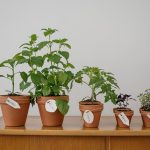So, you're considering cloth pots for your plants. Wondering if they're truly the superior choice? Let's delve into the benefits and considerations.
Cloth pots offer improved aeration and drainage, promoting healthier root systems. They also contribute to environmental sustainability, unlike plastic alternatives.
In this guide, we'll explore the advantages of cloth pots, compare them to plastic pots, and provide tips for selecting the right size and maintaining them.
Whether you're a seasoned gardener or striving for green thumb mastery, understanding the nuances of cloth pots can elevate your plant care game. Let's uncover if cloth pots are indeed the best choice for your thriving green companions.
Key Takeaways
- Cloth pots provide improved aeration and drainage for healthier root systems.
- They promote enhanced root health and overall plant growth.
- Cloth pots prevent waterlogging and root rot by allowing excess water to drain away.
- They offer an environmentally sustainable alternative to plastic pots, reducing plastic waste and having a smaller carbon footprint.
Benefits of Cloth Pots
You'll appreciate the breathability and aeration of cloth pots, which can promote healthier root systems for your plants. Unlike traditional plastic pots, cloth pots allow air to flow through the sides, preventing the roots from becoming root-bound. This improved aeration leads to better nutrient uptake and water drainage, ultimately resulting in improved growth for your plants.
The eco-friendly nature of cloth pots is also worth noting. These pots are typically made from biodegradable materials, making them a sustainable and environmentally conscious choice for your gardening needs. By choosing cloth pots, you're not only investing in the health of your plants but also contributing to a greener, more sustainable planet.
Additionally, the porous nature of cloth pots prevents overheating of the roots, especially in hot weather, which can further contribute to the overall well-being of your plants.
With their ability to foster improved growth and their eco-friendly attributes, cloth pots are indeed a smart choice for any conscientious gardener.
Improved Aeration and Drainage
So, let's talk about the improved aeration and drainage that cloth pots can offer your plants.
When your plants are in cloth pots, the enhanced aeration and drainage can lead to healthier roots.
This means less risk of waterlogging and root rot, keeping your plants happy and thriving.
Enhanced Root Health
To improve the health of your plant roots, cloth pots provide enhanced aeration and drainage, promoting better growth and overall plant health. The enhanced aeration and drainage offered by cloth pots play a crucial role in maintaining root health. By allowing more oxygen to reach the roots, cloth pots promote improved root structure and nutrient absorption.
This is essential for the overall well-being of your plants, as healthy root systems are better equipped to absorb essential nutrients and support the plant's growth. The improved aeration and drainage also help prevent problems such as root rot, which can occur in pots with poor drainage.
Ultimately, opting for cloth pots can significantly enhance the health and vitality of your plant roots, leading to stronger, more resilient plants.
Prevents Waterlogging and Rot
Enhanced aeration and drainage in cloth pots prevent waterlogging and rot, ensuring optimal root health and overall plant vigor.
Cloth pots are beneficial because they prevent overwatering, a common issue in traditional plastic or ceramic containers. The fabric construction allows excess water to drain away, preventing water from pooling at the bottom and causing root rot.
This improved drainage also promotes soil oxygenation, ensuring that the roots have access to the oxygen they need for healthy growth. By preventing waterlogging and facilitating better aeration, cloth pots create an environment that discourages the development of root diseases caused by excessive moisture. This is especially important for plants that are sensitive to overwatering.
Enhanced Root Development
So, let's talk about how cloth pots can really benefit your plant's root development.
The improved aeration and drainage that cloth pots provide allows the roots to breathe and grow more freely.
With better air circulation and water drainage, your plants will establish stronger and healthier root systems, leading to overall improved growth and vitality.
Cloth Pots Promote Aeration
Using cloth pots promotes enhanced root development through improved aeration for your plants. Cloth pots facilitate better aeration, allowing roots to receive more oxygen, crucial for plant growth and soil health. The breathable fabric of cloth pots prevents soil compaction, promoting healthy root development and preventing root circling.
This enhanced aeration also prevents overwatering and waterlogged soil, which is often an issue with traditional pots, leading to improved water retention and preventing the risk of root rot. Additionally, cloth pots provide thermal insulation, protecting roots from temperature extremes and promoting consistent root growth.
The choice of pot material can significantly impact the overall health and vitality of your plants, and cloth pots excel in providing the ideal environment for enhanced root development.
Improved Water Drainage
To ensure enhanced root development, you'll want to focus on improved water drainage by using cloth pots. Cloth pots allow excess water to drain efficiently and prevent waterlogged soil. They promote better water drainage compared to traditional plastic pots, reducing the risk of water retention and soil compaction.
Enhanced water drainage is essential for healthy plant roots. It prevents the roots from sitting in water, which can lead to rot and other issues. By using cloth pots, you create an environment where the roots can access the oxygen they need. This promotes healthier and more robust root development.
This improved drainage also encourages the roots to grow more freely and establish a stronger, more extensive root system. Ultimately, this benefits the overall health and vitality of your plants.
Environmental Sustainability
You should frequently consider the environmental sustainability of your planting containers when choosing the best option for your plants. When it comes to reducing waste, cloth pots offer an eco-friendly alternative to traditional plastic pots.
Consider the following:
- Biodegradability: Cloth pots are often made from natural fibers such as jute or hemp, which are biodegradable. When these pots reach the end of their lifespan, they can be easily composted, reducing the amount of plastic waste in landfills.
- *Environmental Impact*: The production of plastic pots contributes to pollution and resource depletion. In contrast, cloth pots have a lower environmental impact as they're made from renewable materials and have a smaller carbon footprint.
- *Longevity*: While plastic pots may last for multiple seasons, cloth pots can also be quite durable if well cared for. However, when cloth pots do reach the end of their life, they've a smaller environmental impact compared to plastic pots.
Comparison With Plastic Pots
When considering the comparison between cloth pots and plastic pots, it's important to weigh the environmental impact and longevity of each option.
Plastic pots are durable and long-lasting, but they're made from non-renewable resources and can take centuries to decompose. On the other hand, fabric pots are eco-friendly as they're often made from recycled materials and can biodegrade over time.
When it comes to root health, fabric pots have the edge as they prevent roots from becoming root-bound, promoting better aeration and preventing over-watering. Plastic pots, while durable, can cause root circling and water drainage issues if not properly maintained.
Additionally, fabric pots are available in various sizes and shapes, making them versatile for different plant needs, while plastic pots have more limited options. When it comes to cleaning, plastic pots are easier to wipe down, while fabric pots require more effort to clean.
Ultimately, the choice between cloth and plastic plant container options depends on your priorities for environmental impact, root health, water drainage, pot size, and cleaning preferences.
Choosing the Right Cloth Pot Size
Choosing the right cloth pot size is crucial for ensuring optimal root development and plant health. When selecting the size of cloth pots for your plants, there are several factors to consider:
- Plant Size: Choose a cloth pot size that accommodates the current size of your plant. The pot should provide enough space for the roots to spread out and grow without being constricted.
- Proper Drainage: Opt for a size that allows for adequate drainage. If the pot is too large for the plant, excess water may accumulate at the bottom, leading to potential root rot. Conversely, if the pot is too small, it may not drain effectively, causing waterlogged soil.
- Aeration: The size of the pot also influences the aeration of the roots. A larger pot allows for more air circulation around the roots, promoting healthy growth. On the other hand, a pot that's too small can lead to compacted soil and limited oxygen availability.
Maintenance and Cleaning Tips
To maintain and clean your cloth pots, start by gently brushing off any excess soil from the exterior surfaces. This will help prevent the buildup of dirt and debris, keeping your pots in good condition for longer.
For more thorough cleaning, you can hand wash the pots with a mild detergent and warm water. Avoid using harsh chemicals as they can degrade the fabric over time. After washing, allow the pots to air dry completely before using them again.
When it comes to sterilization, there are a few effective methods you can use. One option is to soak the pots in a solution of one part bleach to nine parts water for about 30 minutes, then rinse them thoroughly and let them dry.
Another method is to steam the pots for 20-30 minutes, which can help kill any remaining pathogens. Additionally, you can consider using a natural disinfectant like hydrogen peroxide to sanitize the pots. Whichever method you choose, ensure the pots are completely dry before using them again to prevent any potential damage to your plants.
Regular cleaning and sterilization will help keep your cloth pots in great condition and provide a healthy environment for your plants to thrive.
Frequently Asked Questions
Can Cloth Pots Be Used for All Types of Plants, Including Those That Require a Lot of Water?
Cloth pots can be used for most plants, providing benefits like good drainage and aeration. However, they may not retain water as well as traditional pots, so for plants requiring a lot of water, regular monitoring is essential.
Do Cloth Pots Deteriorate Over Time and Need to Be Replaced More Often Than Plastic Pots?
Yes, cloth pots deteriorate over time and need replacement more often than plastic pots. While cloth pots are effective and have environmental benefits, the longevity of plastic pots may outweigh the cost and environmental impact.
Are Cloth Pots Safe to Use for Indoor Plants, or Do They Cause a Mess and Potential Water Damage?
Cloth pots offer excellent water retention and drainage for indoor and outdoor plants. They're safe for indoor use and won't cause water damage if properly utilized. The mess is minimal, and they provide a healthier environment for your plants.
Can Cloth Pots Be Used in Extreme Weather Conditions, Such as Freezing Temperatures or Intense Heat?
In extreme weather conditions, like freezing temperatures or intense heat, cloth pots offer benefits for root development. Using cloth pots in harsh climates allows for better aeration and insulation, promoting healthier plant growth.
Are There Any Specific Soil Types or Fertilizers That Work Best With Cloth Pots, or Can I Use the Same Ones I Use for Plastic Pots?
You can use the same soil types and fertilizers with cloth pots as you do with plastic pots. Just ensure proper watering frequency and choose plants that suit the cloth material.
- Can You Paint Chiffon Fabric? - April 23, 2024
- Is Chiffon a Lightweight? - April 23, 2024
- Is Chiffon Cool in Hot Weather? - April 23, 2024








